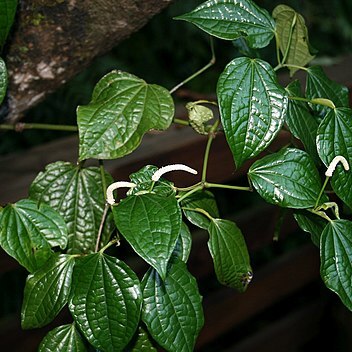A soft wooded straggling herb. It can also be a small tree. It can grow to 4 m high. The bark is light brown and corky. The stems and branches have thickened nodes. The leaves are simple and alternate. The leaves are 7-15 cm long and broad. They are dark green and glossy above. They are paler underneath. The tip tapers towards a point. The base has shallow lobes. The leaf stalk is 2-4 cm long. There are leafy arrangements (stipules) near the leaf stalk. The flowers are white and small. they occur in dense spikes 8 cm long. These are on short side branches. The fruit is a round berry. These are densely clustered along the stalk about 8 cm long. They are green at first then turn black when ripe.
Herb or soft-wooded shrub, sometimes scrambling, rarely small tree, erect or reclining, 0.5-3.0 m high; stems swollen at nodes. Leaves ovate to broadly ovate, palmately 7-nerved, base truncate, apex attenuate, glossy green above, paler below; petiolate, stipules adnate to stem. Inflorescences leaf-opposed, solitary, pedunculate, cylindrical spikes. Flowers subtended by peltate bracts. Stamens 2 or 3; anthers basifixed with thecae usually distinct. Ovary sessile, ovoid; styles short; stigmas 2. Flowering time Aug.-Mar. Fruit compressed-ovoid; pericarp membranous, reddish.
Leaves 5–15.5(18.5) ? 2.5–15(17.5) cm, ovate, rarely elliptic or elliptic-ovate, acuminate at the apex, ± asymmetric and cuneate to rounded or shortly cordate at the base, membranous, discolorous, dark green on upper surface, light green or greyish to glaucous below, glabrous on both surfaces with the nerves ± densely pilose-pubescent towards the base on the lower surface, or the lower surface pilose-pubescent all over, palmately (3)5–11-nerved with the 3 median nerves reaching the apex, impressed above, prominent below.
Flowers: bisexual and male in separate spikes, or both on one spike with male flowers towards the base and hermaphrodite flowers towards the apex; bracts 1–1.5 mm in diameter, subcircular, glabrous above, densely pubescent below and on the petiolule; stamens 2–3; ovary ovoid; style short; stigmas 2, recurved.
Inflorescences consisting of solitary leaf-opposed spikes, terminal, or lateral when overtopped by sympodial growth, creamy-white; peduncles (1)1.5–5.2 cm long, glabrous or ± pilose-pubescent; rhachis (0.7)2.5–8.5(10) cm long, glabrous.
Soft-wooded, straggling shrub, up to 4.5 m high. Inflorescence a catkin, dull white. Leaves dark glossy green and glabrous above, blade ovate, 70-150 x 50-110 mm, 5-7-nerved, quilted.
Soft, straggling shrub to 3 m. Leaves ovate, acuminate, 5-7-veined from base, glossy above, paler and hairy on veins beneath. Flowers in spadix-like spikes, greenish.
An aromatic evergreen shrub or subshrub from a tuberous rootstock, ± erect to c. 3 m high or with scandent or trailing stems 3–4(5) m long.
Stems terete, weak, greenish, with glabrous to ± villous swollen nodes; nodes up to 3 cm wide.
Petiole 0.5–5(8.3) cm long, grooved above near the base, terete below, glabrous or ± villous.
Stipules 1–1.6 cm long, lanceolate, membranous, deciduous.
Fruit sessile 2–4 mm long, spheric-ovoid, obtuse.
A shrub, erect or more or less scandent.


